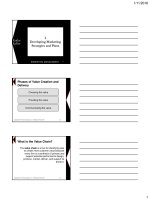Lecture Organizational behavior - Chap 2: Introducing organizational behavior
Bạn đang xem bản rút gọn của tài liệu. Xem và tải ngay bản đầy đủ của tài liệu tại đây (6.28 MB, 41 trang )
Chapter 2
Diversity, Personality, and
Values
Appreciation opens doors to opportunity
Chapter 2 Study Questions
Why are diversity and individual differences
important?
What is personality?
How are personality and stress related?
What are individual and cultural values?
Copyright © 2014 John Wiley & Sons,
Why are diversity and
individual differences
important?
Individual differences attempts to identify
where
behavioral tendencies are similar and where they
are different.
Capitalizing on differences requires an
understanding of what they are and valuing the
benefits they can offer.
Self awareness - being aware of one’s own
behaviors, preferences, styles, biases, personalities,
and so on.
Awareness of others - being aware of the
behaviors, preferences, styles, biases, and
personalities
of others.
Copyright © 2014
John Wiley & Sons,
2-3
Why are diversity and
individual
differences
Components of Self
important?
Self-concept
•
The view individuals have of themselves as
physical, social, spiritual, or moral beings.
• Self-esteem
A belief about one’s self worth based on overall
self-evaluation.
• Self-efficacy
A belief in one’s ability to successfully
accomplish a specific task.
Copyright © 2014 John Wiley & Sons,
2-4
Why are diversity and
individual differences
Nature versus Nurture
important?
Heredity (nature) consists of those factors that are
•
determined at conception, including physical
characteristics, gender, and personality factors.
• Environment (nurture) consists of cultural, social, and
situational factors.
Copyright © 2014 John Wiley & Sons,
2-5
Why are diversity and
individual differences
important?
Copyright © 2014 John Wiley & Sons,
2-6
Why are diversity and
individual differences
important?
Valuing (or not Valuing) Diversity
• Discrimination – the flip side of valuing
diversity against women and minorities in
the workplace.
• Glass Ceiling Effect – An invisible barrier or
“ceiling” that prevents women and
minorities from rising above a certain level
of organizational.
• Race and Ethnicity – The value of
heterogeneous perspectives within teams
and organizations.
Copyright © 2014 John Wiley & Sons,
2-7
Why are diversity and individual
differences important?
Gender
Women bring a different set of skills and
styles to the workplace.
“Leaking pipeline” #of women decreases the
more senior the roles become.
Copyright © 2014 John Wiley & Sons, Inc.
2-8
Why are diversity and
individual differences
Sexual Orientation
important?
Attitudes toward gays and lesbians have steadily
•
improved.
• Many states now have executive orders protecting the
rights of gay and lesbian workers.
Copyright © 2014 John Wiley & Sons,
2-9
Age
Why are diversity and
individual differences
important?
• Diverse workforce (40% Baby Boomers,
36% GenXers, 16% Millennials).
• Generational mix provides an excellent
example of diversity in action.
• Interesting discussion of this subject on
current blogs. (e.g. CNNMoney)
Copyright © 2014 John Wiley & Sons,
2-10
Disability
Why are diversity and
individual differences
important?
• Any form of impairment or handicap.
• Advocates are seeking new definition in order to remove
the stigma that has been associated with the term
‘disability
Copyright © 2014 John Wiley & Sons,
2-11
Why are diversity and
individual differences
important?
Social Identity Theory
• Developed to understand the psychological basis
of discrimination.
• Categorizing yourself as a member of a social
group leads to ‘in-group’ identification.
In-group membership
Out-group membership
Copyright © 2014 John Wiley & Sons,
2-12
What is personality?
Personality
• Combination of characteristics that capture the unique
nature of a person as that person reacts to and interacts
with others.
Copyright © 2014 John Wiley & Sons,
2-13
What is personality?
“Big Five” personality dimensions
• Extraversion
Being outgoing, sociable, assertive.
• Agreeableness
Being good-natured, trusting, cooperative.
• Conscientiousness
Being responsible, dependable, persistent.
• Emotional stability
Being unworried, secure, relaxed.
• Openness to experience
Being imaginative, curious, broad-minded.
Copyright © 2014 John Wiley & Sons,
2-14
What is personality?
Social traits
• Surface-level traits that reflect the way a person appears
to others when interacting in various social settings.
Problemsolving style
• Reflect the way a person gathers and evaluates
information when solving problems and making
decisions.
Copyright © 2014 John Wiley & Sons,
2-15
What is personality?
Information gathering
• Getting and organizing data for use.
• Styles of information gathering range from
sensation to intuitive.
Copyright © 2014 John Wiley & Sons,
2-16
Figure 2.1: Four problemsolving styles of the
Jungian typology
Copyright © 2014 John Wiley & Sons,
2-17
What is personality?
Evaluation in problem solving
• Making judgments about how to deal with information
once it has been collected.
• Styles of information vary from an emphasis on feeling to
an emphasis on thinking.
Copyright © 2014 John Wiley & Sons,
2-18
What is personality?
Personal conception traits
• The way individuals tend to think about their social and
physical settings, as well as their major beliefs and their
personal orientation concerning a range of issues.
Copyright © 2014 John Wiley & Sons,
2-19
What is personality?
Locus of control
• The extent to which a person feels able to control his/her
own life.
• Concerned with a person’s internal-external orientation.
Copyright © 2014 John Wiley & Sons,
2-20
Figure 2.2
Ways in which
internal locus of control differs from
external locus of control
Copyright © 2014 John Wiley &
1-21
What is personality?
Proactive Personality – Disposition that identifies
whether or not individuals act to influence their
environment.
• Show initiative
• Take action
• Persevere until meaningful change occurs
Copyright © 2014 John Wiley & Sons,
2-22
What is personality?
Authoritarianism
• Tendency to adhere rigidly to conventional values and to
obey recognized authority.
Dogmatism
• Leads a person to see the world as a threatening place
and to regard authority as absolute.
Copyright © 2014 John Wiley & Sons,
2-23
What is personality?
People with a high Machiavellian personality:
• Approach situations logically and
thoughtfully.
• Are capable of lying to achieve personal
goals.
• Are rarely swayed by loyalty, friendships,
past promises, or others’ opinions.
• Are skilled at influencing others.
Copyright © 2014 John Wiley & Sons,
2-24
What is personality?
People with a lowMachiavellian personality:
• Accept direction imposed by others in loosely structured
situations.
• Work hard to do well in highly structured situations.
Copyright © 2014 John Wiley & Sons,
2-25









